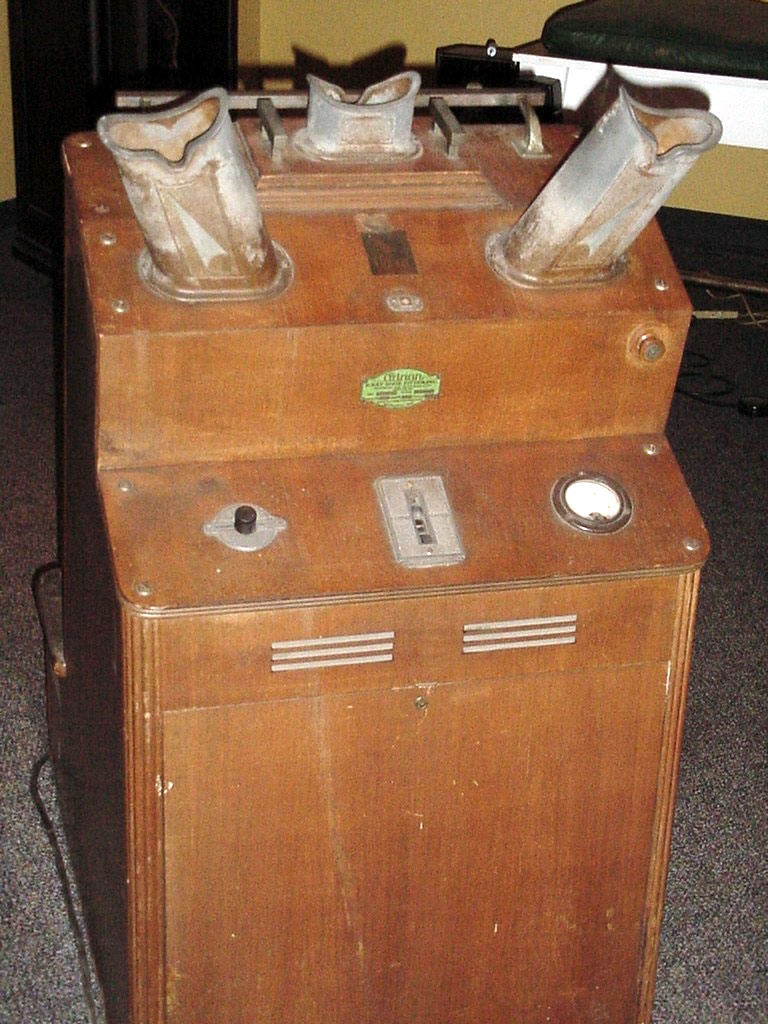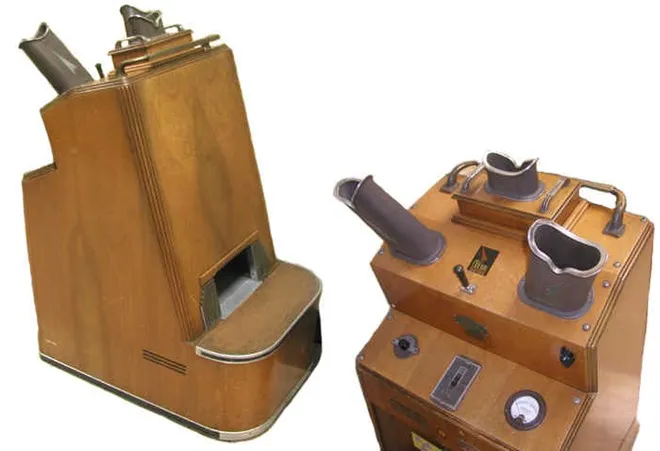In the 20th century, shoe stores across the world introduced an innovative yet risky technology known as the shoe-fitting fluoroscope. This X-ray device was designed to help customers find the perfect shoe fit by allowing them to see the bones of their feet inside the shoe. From the 1920s to the 1970s, the fluoroscope was a common fixture in shoe stores throughout the United States, United Kingdom, Canada, Australia, and many other countries. However, despite its initial popularity, growing concerns about radiation exposure led to its decline.
Let’s take a closer look at this unique invention, from its rise to its eventual fall.
The Origins of the Shoe-Fitting Fluoroscope
The invention of the shoe-fitting fluoroscope is a matter of debate. The device first appeared in shoe stores in the early 1920s and was developed as a modified version of medical X-ray equipment. While several individuals claim credit for inventing it, the most likely inventor is Jacob Lowe, who demonstrated a similar machine at shoe retailer conventions in Boston and Milwaukee in the early 1920s. Lowe filed a U.S. patent application in 1919, which was granted in 1927.
Other claims to the invention include Syl Adrian and Clarence Karrer, both from Milwaukee, as well as the British company Pedoscope, which applied for a British patent in 1924. Despite the conflicting claims, it was the X-ray Shoe Fitter Corporation of Milwaukee and the Pedoscope Company of St. Albans, England, that became the largest manufacturers of these machines.
How the Shoe-Fitting Fluoroscope Worked
The shoe-fitting fluoroscope was essentially a metal device encased in wood, standing about four feet tall. It had a ledge with an opening where the customer would place their feet. Here’s how it worked:
- X-Ray Viewing: The customer (often a child), along with a parent and a salesperson, would peer into viewing ports on top of the machine. Inside, an X-ray view showed the bones of the feet inside the shoes, with the outline of the shoes clearly visible. This allowed customers to see if there was enough room for their toes to move freely.
- Three Viewing Ports: The machine featured three viewing ports—one for the customer, one for the parent, and one for the salesperson. This allowed all parties to confirm the fit at the same time, making it a collaborative experience.
- Fluoroscopic Image: The X-ray produced a live fluoroscopic image of the foot, allowing customers to wiggle their toes and see how the shoes fit in real time. The novelty of seeing bones and shoe outlines made the process quite engaging, especially for children.
While the device seemed innovative, its widespread use posed serious health risks due to high levels of radiation exposure.
Health Risks Associated with Shoe-Fitting Fluoroscopes
From the very beginning, there were concerns about the safety of shoe-fitting fluoroscopes. Radiation burns had been known since Wilhelm Röntgen’s discovery of X-rays in 1895, but the long-term effects of chronic radiation exposure were not fully understood until the 1940s. As the technology became more common, so did the awareness of its dangers.
Radiation Exposure Risks
The most alarming aspect of the shoe-fitting fluoroscope was the level of radiation exposure it produced. Radiation surveys showed that American-made machines delivered an average of 13 roentgens to the feet during a typical 20-second viewing, while some machines could deliver up to 116 roentgens in the same amount of time. British Pedoscopes, however, produced about ten times less radiation.
Cumulative Effects on Customers and Salespersons
The danger wasn’t just to customers, who might try on multiple pairs of shoes during a single visit. It was also a serious occupational hazard for salespeople, who were exposed to radiation daily. Radiation exposure at pelvic height reached up to 95 milliroentgens per week for sales staff, equivalent to about 3.7 millisieverts per year—well above safe levels. Children, who are twice as radiosensitive as adults, were particularly vulnerable to radiation-induced conditions like growth disturbances, burns, and even cancer.

Notable Cases of Radiation Injury
By the 1950s, medical reports began documenting injuries potentially linked to shoe-fitting fluoroscopes. One of the earliest reported cases involved a severe radiation burn in 1950 that required amputation. Another case in 1957 documented dermatitis with ulceration, and a 2004 case reported basal-cell carcinoma of the sole of a shoe salesman’s foot—an extremely rare condition likely caused by chronic radiation exposure.
Decline of the Shoe-Fitting Fluoroscope: Safety Takes Priority
As scientific evaluations of shoe-fitting fluoroscopes in the late 1940s and early 1950s highlighted the significant health risks, regulatory measures began to increase. Here are the key factors that led to the eventual decline of the device:
Increased Awareness of Radiation Hazards
The long-term dangers of radiation exposure became evident as data emerged from atomic bomb survivors and studies of radium dial painters in the 1940s. These cases revealed the genetic effects of radiation and its links to cancer, prompting further scrutiny of fluoroscopes in shoe stores.
Inconsistent Radiation Levels
The machines varied greatly in radiation levels due to design differences, displacement of shielding materials, and inconsistent usage. Some machines had displaced shielding to enhance image quality or to reduce weight, which exacerbated radiation leakage. As awareness grew, so did the demand for stricter safety regulations.

Regulatory Actions and Phase-Out
In the 1950s and 1960s, governments in the United States, United Kingdom, and other countries introduced regulations to control radiation exposure from shoe-fitting fluoroscopes. By the 1970s, the devices were largely phased out, replaced by safer, manual methods of measuring shoe fit.
Legacy of the Shoe-Fitting Fluoroscope: A Cautionary Tale
Today, the shoe-fitting fluoroscope stands as a relic of an era when the allure of new technology often overshadowed safety considerations. While it offered a novel approach to shoe fitting, its eventual phase-out serves as a reminder of the importance of thorough testing and regulation for public health. The fluoroscope’s story is a blend of innovation, risk, and eventual reform, illustrating both the potential and the pitfalls of early 20th-century technological advancements.
Conclusion: Lessons Learned from the Shoe-Fitting Fluoroscope
The history of the shoe-fitting fluoroscope is as fascinating as it is cautionary. While it was once considered a marvel of modern technology, its story underscores the need for rigorous safety measures when introducing new devices, especially those that use radiation. As we look back, the fluoroscope serves as a lesson in balancing innovation with health and safety, reminding us that not all progress is worth the risk.


